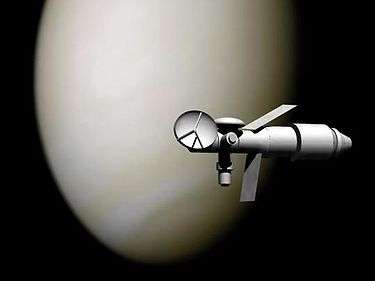TMK

TMK (Russian: Тяжелый Межпланетный Корабль - Tyazhely Mezhplanetny Korabl for Heavy Interplanetary Spacecraft) was the designation of a Soviet space exploration project to send a manned flight to Mars and Venus (TMK-MAVR design) without landing.
The TMK-1 spacecraft was due to be launched in 1971 and make a three-year-long flight including a Mars flyby, at which time probes would have been dropped. Expanded project variations, such as the TMK-E, Mavr or KK, including a Venus flyby, electric propulsion or a manned Mars landing were also proposed.
The TMK project was planned as an answer from the Soviet Union to the United States' manned Moon landings. A previous Martian Piloted Complex mission was proposed in 1956. The project was never completed because the required N1 rocket never flew successfully.
TMK-1
| Mission type | Manned interplanetary |
|---|---|
| Mission duration | 1095 days |
| Spacecraft properties | |
| Spacecraft type | RP-1/LOX |
| Dimensions |
|
| Crew | |
| Crew size | 3 |
| Members | Soviet cosmonauts |
| Start of mission | |
| Launch date | June 8, 1971 (planned) |
| Rocket | N1 |
| End of mission | |
| Landing date | July 10, 1974 (planned) |
| Flyby of Mars | |
| Closest approach | April 1972 (planned) |
The first flight to Mars of the TMK-1 was planned to begin on June 8, 1971.
The 75 metric ton TMK-1 spacecraft would take a crew of three on a Mars flyby mission. After a 10½ month flight the crew would race past Mars, dropping remote-controlled landers, and then be flung into an Earth-return trajectory. Earth return would happen on July 10, 1974, after a voyage of three years, one month, and two days.
Spacecraft configuration:
- A habitation or pilot compartment, with an internal volume of 25 cubic meters
- A work or equipment section, including the hatch for extra-vehicular activities and a solar storm shelter should solar flares increase radiation to dangerous levels. Total volume of the section would be 25 cubic meters.
- A biological systems compartment, with the SOZh closed-cycle environmental control system, with a total volume of 75 cubic meters
- An aggregate section, with the Mars probe capsules, the KDU midcourse correction engine, the SOZh solar concentrator and solar panels, and radio antennas
- The SA crew Earth reentry capsule, about 4 m in diameter
TMK-E
| Mission type | Manned interplanetary |
|---|---|
| Mission duration | 1096 days |
| Spacecraft properties | |
| Spacecraft type | Nuclear electric (Xenon) Thrust: 74 newtons (17 lbf) |
| Dimensions |
|
| Crew | |
| Crew size | 6 |
| Members | Soviet cosmonauts |
| Start of mission | |
| Rocket | N1 |
| Mars lander | |
This variation was proposed in 1960, and consisted of a complete Mars landing expedition to be assembled in Earth orbit using several N1 launches. The spacecraft would be powered by nuclear electric engines and five landers would deliver a nuclear-powered Mars Train on the surface for a one-year mission.
The TMK-E would be capable of a three-year flight to Mars and return, of which one year was powered flight. It would measure 175 m in length and house a crew of six. Six landing craft were included, two for the crew and four for the Mars Train vehicles.
Mavr (MArs - VeneRa)
| Mission type | Manned interplanetary |
|---|---|
| Mission duration | 680 days |
| Spacecraft properties | |
| Spacecraft type | RP-1/LOX |
| Dimensions |
|
| Crew | |
| Crew size | 3 |
| Members | Soviet cosmonauts |
| Start of mission | |
| Rocket | N1 |
| Flyby of Mars | |
| Flyby of Venus | |
A variation of the TMK mission planning involved a flyby of Venus on the return voyage, and was given the code name "Mavr" (MArs - VeneRa), meaning Mars - Venus.
KK - Space Complex for Delivering a Piloted Expedition to Mars
| KK - Space Complex for Delivering a Piloted Expedition to Mars | ||
|---|---|---|
| Description | ||
| Role: | Mars Expedition | |
| Crew: | three | |
| Rocket engines | ||
| Main Engine (Xenon) : | 14 lbf ea | 61 N |
| Performance | ||
| Endurance: | 630 days | 30 days Mars stay |
In 1966, a final version of the TMK studies was known as KK - Space Complex for Delivering a Piloted Expedition to Mars. Nuclear electric propulsion was to be used for the 630-day mission. The craft structure consisted of:
- EK - Expeditionary spacecraft: command center for piloting in interplanetary space
- OK - Orbital Complex: living and work compartments and the life support systems
- SA - The Landing Module, AV - The Ascent Module and RV - The Ascent Rocket stage
- PS - The Planetary Station: used by the expedition on the Martian surface for life support and scientific research
The launch was planned for 1980, with a crew of three cosmonauts. Mars stay duration would be 30 days.
Mission data:
- Total Payload Required in Low Earth Orbit-metric tons: 150
- Total Propellant Required-metric tons: 24
- Number of Launches Required to Assemble Payload in Low Earth Orbit: 2
- Launch Vehicle: N1